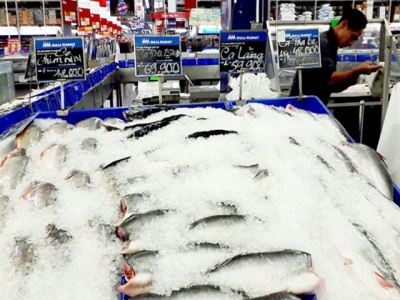Costs cause seafood firms to sink

HÀ NỘI – Rising production costs are harming the competitiveness of Vietnamese seafood products, according to experts. These include the prices of feed, material input, electricity and labour.
Production costs are increasing, causing difficulties for Vietnamese seafood producers. - Photo thoibaokinhdoanh
The average retail price for power increased 8.36 per cent last Wednesday, according to the Ministry of Industry and Trade (MoIT).
The hike means that electricity bills have risen from VNĐ1,720 (7.49 US cents) per kWh to VNĐ1,864 (8.03 cents), excluding VAT.
Power tariffs for businesses and industrial zones are now divided into two levels: VNĐ3,076 per kWh for peak hours and VNĐ970 per kWh for off-peak hours.
Dương Nghĩa Quốc, chairman of the Việt Nam Pangasius Association, said the increase in power prices has worried tra fish producers because rising input costs will impact production and selling prices.
Quốc was quoted by the Nông thôn ngày nay newspaper as saying that at present, electricity consumption for farming and processing of aquatic products as well as operation of aquatic feed factories is significant. Competition at home and abroad is also becoming increasingly fierce.
For instance, a tra fish (pangasius) processing factory with medium capacity in Đồng Tháp Province usually pays VNĐ10 billion for electricity each month. With the latest increase in power prices, factories will be paying many times more.
Freezers and air conditioning systems at seafood processing enterprises, especially factories processing seafood products for export, accounts for over 85 per cent of total power consumption, he said.
The tra fish industry has suggested that the electricity sector should consider and adopt reasonable policies to create favorable conditions for production, especially in the agricultural and fishery sectors.
Electricity prices should increase according to a schedule with an initial surge rate of 3-4 per cent, followed by suitable changes. An immediate price increase of 8.36 per cent is a shock to enterprises, according to Quốc.
The State should offer preferential loans for businesses to convert old electrical equipment to new machines, as well as promoting the use of renewable energy resources, he said.
Many businesses want to use clean energy but for a large factory, the investment cost for clean energy could be as high as VNĐ10 billion, or even VNĐ30 billion. Facing difficulties in production, businesses are already struggling to get credit or attract investment.
Quốc said businesses will have to increase the price of products due to higher production costs. If tra fish consumption is slow, meaning the products are stocked for longer, selling prices will increase due to fees paid for warehouses.
Labour
Seafood processing enterprises also face pressure from increasing labour costs due to difficulties in finding workers, especially enterprises in HCM City and the Mekong Delta.
Many enterprises have increased salaries to about VNĐ8-10 million per month, and even VNĐ14 million for experienced workers, but they still struggle with a shortage. Many workers have changed jobs because they said their incomes were unstable and the working environment was hazardous.
Hồ Quốc Lực, general director of the Sao Ta Food Joint Stock Company, a leading shrimp exporter, said the cost of feed in Việt Nam is higher compared to other countries. The production cost for one kilo of shrimp in Việt Nam is about $1 higher than in neighbouring countries.
Additionally, the cost of antibiotics has put pressure on the domestic shrimp industry.
Lê Văn Quang, chairman and general director of the Minh Phú Seafood Corporation, said the cost of antibiotics is about VNĐ6,000 per kilo of raw shrimp, pushing up prices and harming competitiveness.
The price of raw shrimp is also a big challenge for many seafood processing enterprises, reported the Thời báo kinh doanh newspaper.
The supply of aquatic materials is unstable due to reductions in fishery resources and severe weather. Farmers are raising aquatic products on a small scale, with low capacity.
Việt Nam has imported a large volume of feed, shrimp seed, fish fingerling and other material for aquatic production.
Therefore, large seafood producers have actively developed large-scale material regions with high capacities to reduce production costs and control quality and hygiene.
Minh Phú has developed a high-tech, large-scale shrimp farm to increase supply of shrimp each year.
The Sao Ta Food Joint Stock Company last year invested in 40 extra hectares of ponds to rear shrimp.
Vĩnh Hoàn JSC this year will expand its tra fish farming area by 220ha to increase its supply by 40 per cent against last year. Processing capacity will also increase from 850 tonnes of raw materials per day at present to 1,130 tonnes in the next two years.
Nam Việt Joint Stock Company earlier this year started construction on a high-tech tra fish farming region with an area of 600ha and total investment of VNĐ4 trillion in An Giang Province. This region will help the company meet its target of raising processing capacity from 600 tonnes of raw materials per day to 1,100 tonnes.
Related news
 Tra fish industry needs to improve product quality
Tra fish industry needs to improve product quality Việt Nam’s tra fish (pangasius) industry has been urged to strongly improve its quality so as to compete with not only traditional rivals, but also its biggest
 Shellfishiency Oyster farmers step boldly into the digital age
Shellfishiency Oyster farmers step boldly into the digital age With a growing client list, Oyster Tracker is helping producers track inventory and predict farm performance
 Vietnam’s tuna export to China shoots up
Vietnam’s tuna export to China shoots up Vietnam’s export of tuna to China rocketed by 771 percent in the first two months of this year, making the market the fifth largest importer of Vietnamese tuna